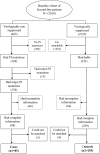Predictors of failure on second-line antiretroviral therapy with protease inhibitor mutations in Uganda
- PMID: 33882938
- PMCID: PMC8059285
- DOI: 10.1186/s12981-021-00338-y
Predictors of failure on second-line antiretroviral therapy with protease inhibitor mutations in Uganda
Abstract
Introduction: Failure on second-line antiretroviral therapy (ART) with protease inhibitor (PI) mutations (VF-M) is on the rise. However, there is a paucity of information on the factors associated with this observation in low-income countries. Knowledge of underlying factors is critical if we are to minimize the number of PLHIV switched to costly third-line ART. Our study investigated the factors associated with VF-M.
Methods: We conducted a matched case-control analysis of patients' records kept at the Joint Clinical Research Center, starting from January 2008 to May 2018. We matched records of patients who failed the second-line ART with major PI mutations (cases) with records of patients who were virologically suppressed (controls) by a ratio of 1:3. Data analysis was conducted using STATA Version 14. Categorical variables were compared with the outcomes failure on second-line ART with PI mutations using the Chi-square and Fisher's exact tests where appropriate. Conditional logistic regression for paired data was used to assess the association between the outcome and exposure variables, employing the backward model building procedure.
Results: Of the 340 reviewed patients' records, 53% were women, and 6.2% had previous tuberculosis treatment. Males (aOR = 2.58, [CI 1.42-4.69]), and patients concurrently on tuberculosis treatment while on second-line ART (aOR = 5.65, [CI 1.76-18.09]) had higher odds of VF-M. ART initiation between 2001 and 2015 had lower odds of VF-M relative to initiation before the year 2001.
Conclusion: Males and patients concomitantly on tuberculosis treatment while on second-line ART are at a higher risk of VF-M. HIV/AIDS response programs should give special attention to this group of people if we are to minimize the need for expensive third-line ART. We recommend more extensive, explorative studies to ascertain underlying factors.
Keywords: Predictors; Protease inhibitor mutations; Second-line ART failure; Uganda.
Conflict of interest statement
The authors declare that they have no competing interests.
Similar articles
-
Incidence and predictors of early loss to follow up among patients initiated on protease inhibitor-based second-line antiretroviral therapy in southwestern Uganda.AIDS Res Ther. 2021 Mar 20;18(1):7. doi: 10.1186/s12981-021-00331-5. AIDS Res Ther. 2021. PMID: 33743748 Free PMC article.
-
Determinants of switch to paediatric second-line antiretroviral therapy after first-line failure in Cameroon.Trop Med Int Health. 2021 Aug;26(8):927-935. doi: 10.1111/tmi.13595. Epub 2021 May 13. Trop Med Int Health. 2021. PMID: 33905593
-
Longer-term effectiveness of protease-inhibitor-based second line antiretroviral therapy in four large sub-Saharan African clinics.J Infect. 2019 May;78(5):402-408. doi: 10.1016/j.jinf.2019.03.003. Epub 2019 Mar 6. J Infect. 2019. PMID: 30849438
-
Short term adherence tool predicts failure on second line protease inhibitor-based antiretroviral therapy: an observational cohort study.BMC Infect Dis. 2014 Dec 4;14:664. doi: 10.1186/s12879-014-0664-3. BMC Infect Dis. 2014. PMID: 25472544 Free PMC article.
-
Predictors of HIV virological failure and drug resistance in Chinese patients after 48 months of antiretroviral treatment, 2008-2012: a prospective cohort study.BMJ Open. 2017 Sep 7;7(9):e016012. doi: 10.1136/bmjopen-2017-016012. BMJ Open. 2017. PMID: 28882911 Free PMC article.
Cited by
-
Determinants of virological failure among HIV clients on second-line antiretroviral treatment at Felege-hiwot and University of Gondar comprehensive specialized hospitals in the Amhara Region, Northwest Ethiopia: A case-control study.PLoS One. 2024 Jul 9;19(7):e0289450. doi: 10.1371/journal.pone.0289450. eCollection 2024. PLoS One. 2024. PMID: 38980874 Free PMC article.
-
Incidence of switching to second-line antiretroviral therapy and its predictors among children on antiretroviral therapy at general hospitals, Northern Ethiopia: A survival analysis.PLoS One. 2023 Sep 8;18(9):e0288132. doi: 10.1371/journal.pone.0288132. eCollection 2023. PLoS One. 2023. PMID: 37683027 Free PMC article.
-
Treatment failure, death, and predictors among PLWHIV on second-line antiretroviral therapy in Dessie Comprehensive Specialized Hospital, northeast Ethiopia: A retrospective cohort study.PLoS One. 2022 Jun 1;17(6):e0269235. doi: 10.1371/journal.pone.0269235. eCollection 2022. PLoS One. 2022. PMID: 35648771 Free PMC article.
-
HIV-1 Protease as DNA Immunogen against Drug Resistance in HIV-1 Infection: DNA Immunization with Drug Resistant HIV-1 Protease Protects Mice from Challenge with Protease-Expressing Cells.Cancers (Basel). 2022 Dec 30;15(1):238. doi: 10.3390/cancers15010238. Cancers (Basel). 2022. PMID: 36612231 Free PMC article.
-
Virological Non-Suppression, Non-Adherence and the Associated Factors Among People Living with HIV on Dolutegravir-Based Regimens: A Retrospective Cohort Study.HIV AIDS (Auckl). 2024 Mar 21;16:95-107. doi: 10.2147/HIV.S449947. eCollection 2024. HIV AIDS (Auckl). 2024. PMID: 38533311 Free PMC article.
References
-
- M.O.H. Uganda population-based HIV impact assessment. 2016, Ministry of Health.
-
- Wu J. HIV/AIDS in Sub-Saharan Africa: to what extent is poverty responsible for the high prevalence. AMSA J Global Health. 2019;13(2):37–41.
-
- Moh U. Uganda HIV/AIDS country progress report July 2016-JUNE 2017. july 2016-June 2017, Ministry of Health Uganda.
Publication types
MeSH terms
Substances
LinkOut - more resources
Full Text Sources
Other Literature Sources
Medical
Research Materials
Miscellaneous


